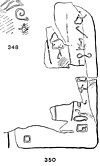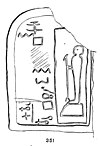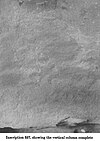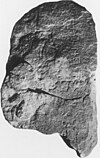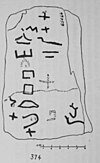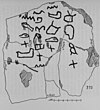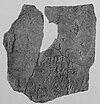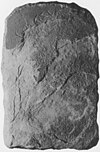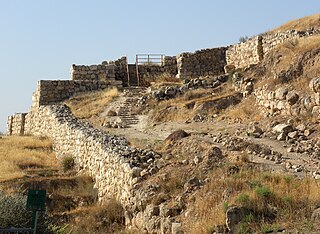
Lachish was an ancient Canaanite and Israelite city in the Shephelah region of Israel, on the south bank of the Lakhish River, mentioned several times in the Hebrew Bible. The current tell (ruin) by that name, known as Tel Lachish or Tell ed-Duweir, has been identified with the biblical Lachish. Today, it is an Israeli national park operated and maintained by the Israel Nature and Parks Authority. It lies near the present-day moshav of Lakhish.

Amenemhat III, also known as Amenemhet III, was a pharaoh of ancient Egypt and the sixth king of the Twelfth Dynasty of the Middle Kingdom. He was elevated to throne as co-regent by his father Senusret III, with whom he shared the throne as the active king for twenty years. During his reign, Egypt attained its cultural and economic zenith of the Middle Kingdom.

Asherah is the great goddess in ancient Semitic religion. She also appears in Hittite writings as Ašerdu(s) or Ašertu(s). Her name was Aṯeratum to the Amorites, and Athiratu in Ugarit. Significantly, Yahweh and Asherah were a consort pair in ancient Israel and Judah.

Serabit el-Khadim is a locality in the southwest Sinai Peninsula, Egypt, where turquoise was mined extensively in antiquity, mainly by the ancient Egyptians. Archaeological excavation, initially by Sir Flinders Petrie, revealed ancient mining camps and a long-lived Temple of Hathor, the Egyptian goddess who was favoured as a protector in desert regions and known locally as the mistress of the turquoise. The temple was first established during the Middle Kingdom in the reign of Sesostris I and was partly reconstructed in the New Kingdom.

Usermaatre Heqamaatre Setepenamun Ramesses IV was the third pharaoh of the Twentieth Dynasty of the New Kingdom of Ancient Egypt. He was the second son of Ramesses III and became crown prince when his elder brother Amenherkhepshef died aged 15 in 1164 BC, when Ramesses was only 12 years old. His promotion to crown prince:
is suggested by his appearance in a scene of the festival of Min at the Ramesses III temple at Karnak, which may have been completed by Year 22 [of his father's reign].

Sir Alan Henderson Gardiner, was an English Egyptologist, linguist, philologist, and independent scholar. He is regarded as one of the premier Egyptologists of the early and mid-20th century.

The Nabataean script is an abjad that was used to write Nabataean Aramaic and Nabataean Arabic from the second century BC onwards. Important inscriptions are found in Petra, the Sinai Peninsula, and other archaeological sites including Abdah and Mada'in Saleh in Saudi Arabia.

Amenemhat IV was the seventh and penultimate king of the late Twelfth Dynasty of Egypt during the late Middle Kingdom period. He arguably ruled around 1786–1777 BC for about nine regnal years.
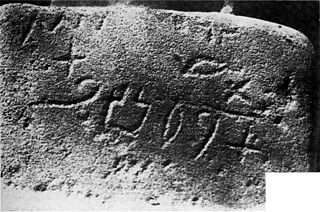
Proto-Sinaitic is found in a small corpus of about 40 inscriptions and fragments, the vast majority from Serabit el-Khadim in the Sinai Peninsula, dating to the Middle Bronze Age. They are considered the earliest trace of alphabetic writing and the common ancestor of both the Ancient South Arabian script and the Phoenician alphabet, which led to many modern alphabets including the Greek alphabet. According to common theory, Canaanites or Hyksos who spoke a Canaanite language repurposed Egyptian hieroglyphs to construct a different script.

Iry-Hor was a predynastic pharaoh of Upper Egypt during the 32nd century BC. Excavations at Abydos in the 1980s and 1990s and the discovery in 2012 of an inscription of Iry-Hor in Sinai confirmed his existence. Iry-Hor is the earliest ruler of Egypt known by name and is sometimes cited as the earliest-living historical person known by name.
The royal titulary or royal protocol is the standard naming convention taken by the pharaohs of ancient Egypt. It symbolised worldly power and holy might, also acting as a sort of mission statement for the duration of a monarch's reign.

Mount Sinai is the mountain at which the Ten Commandments were given to Moses by God, according to the Book of Exodus in the Hebrew Bible. In the Book of Deuteronomy, these events are described as having transpired at Mount Horeb. "Sinai" and "Horeb" are generally considered by scholars to refer to the same place.

The Byblos script, also known as the Byblos syllabary, Pseudo-hieroglyphic script, Proto-Byblian, Proto-Byblic, or Byblic, is an undeciphered writing system, known from ten inscriptions found in Byblos, a coastal city in Lebanon. The inscriptions are engraved on bronze plates and spatulas, and carved in stone. They were excavated by Maurice Dunand, from 1928 to 1932, and published in 1945 in his monograph Byblia Grammata. The inscriptions are conventionally dated to the second millennium BC, probably between the 18th and 15th centuries BC.
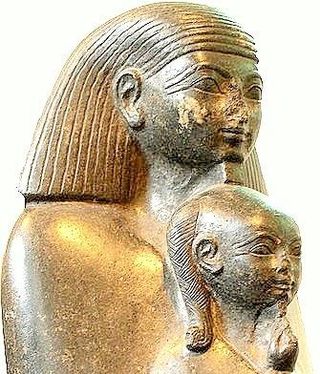
Neferure or Neferura was an Egyptian princess of the Eighteenth Dynasty of Egypt. She was the daughter of two pharaohs, Hatshepsut and Thutmose II. She served in high offices in the government and the religious administration of Ancient Egypt.

Mining in Egypt has had a long history that dates back to predynastic times. Active mining began in Egypt around 3000 BCE. Egypt has substantial mineral resources, including 48 million tons of tantalite, 50 million tons of coal, and an estimated 6.7 million ounces of gold in the Eastern Desert. The total real value of minerals mined was about LE 102 million (US$18.7 million) in 1986, up from LE 60 million (US$11 million) in 1981. The chief minerals in terms of volume output were iron ore, phosphates, and salt. The quantities produced in 1986 were estimated at 2,048, 1,310, and 1,233 tons, respectively, compared with 2,139, 691, and 883 tons in 1981. In addition, minor amounts of asbestos (313 tons) and quartz (19 tons) were mined in 1986. Preliminary exploration in Sinai indicated the presence of zinc, tin, lead, and copper deposits. Private sector exploration and exploitation activities so far have been limited. Only recently, AngloGold Ashanti with its joint Venture Partner Thani Dubai and a Canadian listed exploration company, Alexander Nubia International have been undertaking exploration in Egypt's Eastern Desert with some success. Centamin Ltd., a mineral exploration company founded in Australia, started a massive mining project in Sukari Hill.
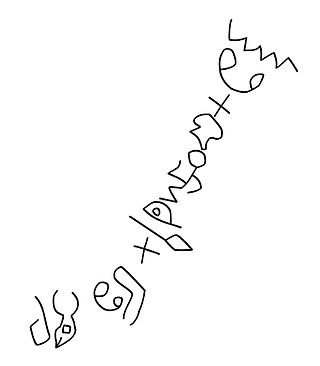
The Wadi el-Hol inscriptions are two rock inscriptions which appear to show the oldest examples of phonetic alphabetic writing discovered to date.

Kirsopp Lake was an English New Testament scholar, Church historian, Greek palaeographer, and Winn Professor of Ecclesiastical History at Harvard Divinity School.

Samaria was a city in the historical region of Samaria that served as the capital of the northern Kingdom of Israel during the 9th and 8th centuries BCE. Towards the end of the 8th century BCE, possibly in 722 BCE, Samaria was captured by the Neo-Assyrian Empire and became an administrative center under Assyrian, Babylonian, and Persian rule. During the early Roman period, the city was expanded and fortified by Herod the Great, who renamed it "Sebastia" in honor of emperor Augustus.

Hilda Mary Isabel, Lady Petrie, was an Irish-born British Egyptologist and wife of Sir Flinders Petrie, the father of scientific archaeology. Having studied geology, she was hired by Flinders Petrie at age 25 as an artist, which led to their marriage and a working partnership that endured for their lifetimes.
Tell Ras Budran is an Ancient Egyptian site on which an Ancient fort was built. The site is located in the Sinai peninsula and lies 150 meters away from the shore of Gulf of Suez. It is located not far from the most important as well as one of the oldest known mining areas for copper and turquoise in the Sinai Peninsula. Less than 50 km away are the Wadi Maghareh to the southeast and the temple complex of Serabit el-Khadim to the east.









